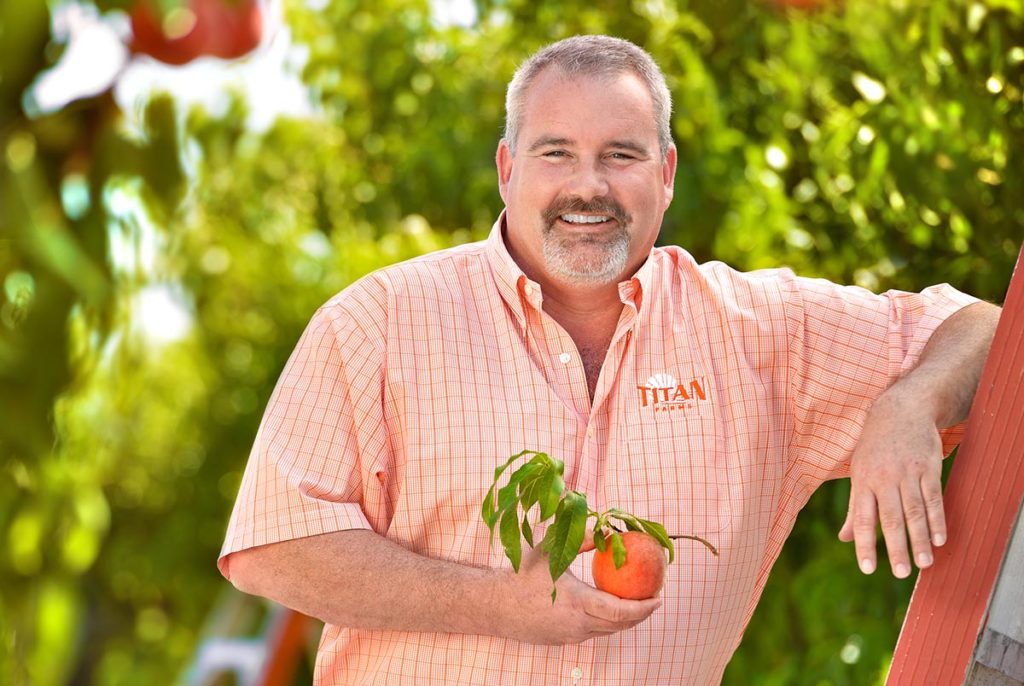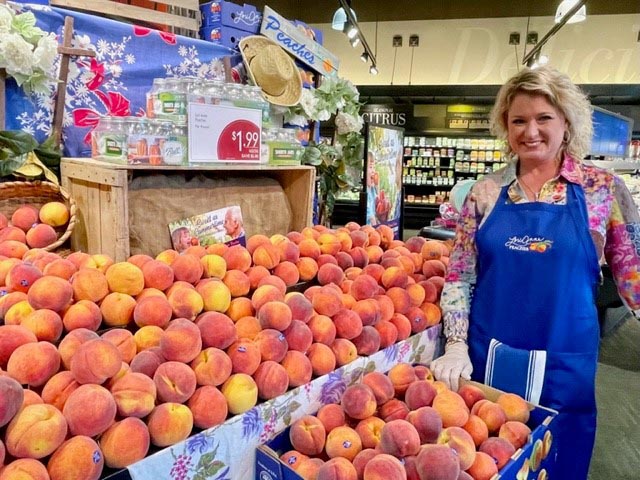Risk mitigation through variety diversity helps Titan Farms succeed.
By Clint Thompson
Adaptability fuels Titan Farms’ success as a national leader in peach production. It will be the key for Chalmers Carr as his South Carolina-based farming operation navigates the current challenges facing peach producers.

“There are generational farms where people may not want to have the same risk profile. They’re slower to adapt to technology,” says Carr, owner of Titan Farms in Ridge Spring. “I think not having a grandfather or father telling me ‘that’s not how we did things,’ we were able to adapt.”
Instead of staying with the status quo and resisting change, Carr rolled with the changing times and helped grow a farming enterprise from 1,500 acres to more than 6,000 acres. Titan Farms also produces bell peppers and broccoli, but it is with peaches that Titan Farms has established itself as a potent producer in the Southeast.
“This is what we wanted to do. This is our dream. The name Titan is there for a reason. That’s kind of the persona,” Carr says. “Some people do things large and don’t have a quality product. I’ve always said you can be the largest and still bring quality to the table. Marrying those two together, we were able to be very successful.”

RISKY BUSINESS
With success comes growing pains. Twice in Carr’s career, he has experienced catastrophic damage with more than 75% of his fruit lost due to a late-season freeze event. But these experiences have educated Carr about the value of protecting his investment.
“In 2017 (after a freeze), I think we opened the packing shed for maybe a month, versus four months,” Carr says. “That’s also the risk side of it. Being a smart business owner, we participate in the federal crop insurance program. We not only participate in it; we advocate for it. We wear advocacy hats outside of the farm on H-2A and crop insurance. We go to D.C. and engage on behalf of all the growers. That’s just something we’ve always believed in.”
Very rarely does Carr grow a crop where every variety produces well. That is why his production portfolio includes 46 different peach varieties.
“If you’re in California, the largest peach grower in the country, you can grow 13 varieties in that climate. But here, we have to grow three varieties in every window just to ensure we’re going to have peaches,” Carr says. “I’ve had two 100% crop years in my entire career. Those don’t happen very often. Something’s going to go wrong somewhere. Not only do I have all those different varieties, but I might have eight different locations where one of those varieties grows.”
Carr says hail, frost in the spring or a lack of dormancy are all factors that can affect his peach season. “We’ve had a mild winter, and with a mild year, you could have a 650-chill-hour variety that might bloom early and get frosted out. Then there’s an 850-chill-hour variety that may not get the winter it needs and may not produce any fruit. Those are all the risk profiles and why you have to grow so many different varieties.”
DECREASED CONSUMPTION
The challenge that all peach producers must overcome now is the reality that consumer consumption is not what it used to be. Carr says per capita consumption of peaches has decreased from a record high of 8 pounds per person to about 5 pounds.
“I think right now if you ran the reports, it would be about 3 pounds per person. Even though we’ve had population growth, consumption has gone down. It’s not that peaches don’t taste good, it’s really all of the other competitive commodities we’ve got,” Carr says. “People have more choices. You go into grocery stores, and you see a lot more different products. You’ve got berries year-round. The off-shore stone fruit in the wintertime doesn’t do us any favors because it sometimes doesn’t eat well. Then the consumer gets turned off by that.”
The way consumers conduct their shopping affects the peach industry as well. More people utilize home-delivery systems in purchasing their groceries, forgoing looking at and smelling produce in the name of convenience. That has forced Carr to rethink how peaches can be marketed more efficiently.
“Peaches, in my opinion, are an impulse buy, as a lot of fruit is. You walk into the grocery store, and you have disposable dollars and there’s a display of peaches or a display of strawberries, and you get to choose. If you’re buying your groceries online behind a computer, you don’t get to see or smell those peaches,” Carr says. “I’ve spent a lot of my time and energy understanding digital marketing and how we’re going to play in that space.”
GOOD CROP IN THE MAKING
Carr will soon begin marketing this year’s peach crop as harvest season is on the horizon.
Warmer temperatures this winter led to peach trees blooming earlier in the production season. He says he had one orchard that had 50% blooms on Feb. 13 with five or six more orchards that had open flowers. The same varieties that Carr has produced for so many years were moved up seven to 10 days earlier.
Carr is optimistic about this year’s crop despite warming trends this winter that reduced chill hours. However, he believes his crop fared better with chill hour accumulations than those in Georgia.
“I’ve probably got everything I need (chill hours) for 85% of my acreage. Then there’s 15% of my acreage that is probably going to be questionable. If I was in Georgia, that would probably be 50% of my acreage, but they don’t grow as late as I do,” Carr says. “I have a lot of peaches in August, and that’s where some of that (questionable) acreage would be. I’m not overly worried about it, but I could be too optimistic. You have to be optimistic to be in this business. All things considered, we should still be in a good position for a very good crop.”
Carr uses the offseason to prepare for what is always a perfect storm of production once the peaches mature and are ready for harvest.
“To tell you the truth, being an owner, the summer is easier than it is this time of year (winter/spring), when you’re doing all the planning. The summer is like a football game; you’re executing the game plan. You’ve done all your homework. In the summer, you’ve got a harvest team, a packing team and a processing team doing all their jobs. We’re loading 50 to 60 trucks per day out of the farm. It can be fun,” Carr says.









